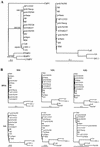Genetic diversity within human erythroviruses: identification of three genotypes
- PMID: 12186896
- PMCID: PMC136440
- DOI: 10.1128/jvi.76.18.9124-9134.2002
Genetic diversity within human erythroviruses: identification of three genotypes
Abstract
B19 virus is a human virus belonging to the genus Erythrovirus: The genetic diversity among B19 virus isolates has been reported to be very low, with less than 2% nucleotide divergence in the whole genome sequence. We have previously reported the isolation of a human erythrovirus isolate, termed V9, whose sequence was markedly distinct (>11% nucleotide divergence) from that of B19 virus. To date, the V9 isolate remains the unique representative of a new variant in the genus Erythrovirus, and its taxonomic position is unclear. We report here the isolation of 11 V9-related viruses. A prospective study conducted in France between 1999 and 2001 indicates that V9-related viruses actually circulate at a significant frequency (11.4%) along with B19 viruses. Analysis of the nearly full-length genome sequence of one V9-related isolate (D91.1) indicates that the D91.1 sequence clusters together with but is notably distant from the V9 sequence (5.3% divergence) and is distantly related to B19 virus sequences (13.8 to 14.2% divergence). Additional phylogenetic analysis of partial sequences from the V9-related isolates combined with erythrovirus sequences available in GenBank indicates that the erythrovirus group is more diverse than thought previously and can be divided into three well-individualized genotypes, with B19 viruses corresponding to genotype 1 and V9-related viruses being distributed into genotypes 2 and 3.
Figures




References
-
- Anderson, M. J., S. E. Jones, S. P. Fisher-Hoch, E. Lewis, S. M. Hall, C. L. Bartlett, B. J. Cohen, P. P. Mortimer, and M. S. Pereira. 1983. Human parvovirus, the cause of erythema infectiosum (fifth disease)? Lancet i:1378. - PubMed
-
- Arens, M. 2001. Clinically relevant sequence-based genotyping of HBV, HCV, CMV, and HIV. J. Clin. Virol. 22:11-29. - PubMed
-
- Astell, C. R., W. Luo, J. Brunstein, and J. St. Amand. 1997. B19 parvovirus: biochemical and molecular features, p. 16-41. In L. J. Anderson and N. S. Young (ed.), Human parvovirus B19, 1st ed., vol. 20. Karger, New York, N.Y.
-
- Auguste, V., A. Garbarg-Chenon, and Q. T. Nguyen. June 1999. Erythrovirus and its applications. French patent WO9928439.
Publication types
MeSH terms
Substances
LinkOut - more resources
Full Text Sources
Other Literature Sources

